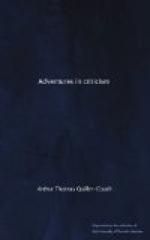I appeal to all who earn their living by pen or brush—Who does not know moods such as this? Who has not experience of those dark days when the ungrateful canvas refuses to come right, and the artist sits down before it and calls himself a fraud? We may even say that these fits of incapacity and blank despondency are part of the cost of all creative work. They may be intensified by terror for the family exchequer. The day passes in strenuous but futile effort, and the man asks himself, “What will happen to me and mine if this kind of thing continues?” Stevenson, we are allowed to say (for the letters tell us), did torment himself with these terrors. And we may say further that, by whatever causes impelled, he certainly worked too hard during the last two years of his life. With regard to the passage quoted, what seems to me really melancholy is not the baseless self-distrust, for that is a transitory malady most incident to authorship; but that, could a magic carpet have transported Stevenson at that moment to the side of the friend he addressed—could he for an hour or two have visited London—all this apprehension had been at once dispelled. He left England before achieving his full conquest of the public heart, and the extent of that conquest he, in his exile, never quite realized. When he visited Sydney, early in 1893, it was to him a new and disconcerting experience—but not, I fancy altogether unpleasing—digito monstrari, or, as he puts it elsewhere, to “do the affable celebrity life-sized.” Nor do I think he quite realized how large a place he filled in the education, as in the affections, of the younger men—the Barries and Kiplings, the Weymans, Doyles and Crocketts—whose courses began after he had left these shores. An artist gains much by working alone and away from chatter and criticism and adulation: but his gain has this corresponding loss, that he must go through his dark hours without support. Even a master may take benefit at times—if it be only a physical benefit—from some closer and handier assurance than any letters can give of the place held by his work in the esteem of “the boys.”
We must not make too much of what he wrote in this dark mood. A few days later he was at work on Weir of Hermiston, laboring “at the full pitch of his powers and in the conscious happiness of their exercise.” Once more he felt himself to be working at his best. The result the world has not yet been allowed to see: for the while we are satisfied and comforted by Mr. Colvin’s assurances. “The fragment on which he wrought during the last month of his life gives to my mind (as it did to his own) for the first time the true measure of his powers; and if in the literature of romance there is to be found work more masterly, of more piercing human insight and more concentrated imaginative wisdom, I do not know it.”
On the whole, these letters from Vailima give a picture of a serene and—allowance being made for the moods—a contented life. It is, I suspect, the genuine Stevenson that we get in the following passage from the letter of March, 1891:—




